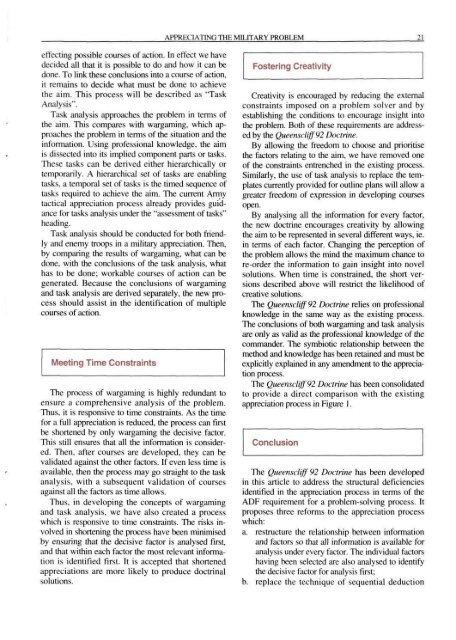ISSUE 107 : Jul/Aug - 1994 - Australian Defence Force Journal
ISSUE 107 : Jul/Aug - 1994 - Australian Defence Force Journal
ISSUE 107 : Jul/Aug - 1994 - Australian Defence Force Journal
You also want an ePaper? Increase the reach of your titles
YUMPU automatically turns print PDFs into web optimized ePapers that Google loves.
APPRECIATING THE MILITARY PROBLEM 21effecting possible courses of action. In effect we havedecided all that it is possible to do and how it can bedone. To link these conclusions into a course of action,it remains to decide what must be done to achievethe aim. This process will be described as "TaskAnalysis".Task analysis approaches the problem in terms ofthe aim. This compares with wargaming. which approachesthe problem in terms of the situation and theinformation. Using professional knowledge, the aimis dissected into its implied component parts or tasks.These tasks can be derived either hierarchically ortemporarily. A hierarchical set of tasks are enablingtasks, a temporal set of tasks is the timed sequence oftasks required to achieve the aim. The current Armytactical appreciation process already provides guidancefor tasks analysis under the "assessment of tasks"heading.Task analysis should be conducted for both friendlyand enemy troops in a military appreciation. Then,by comparing the results of wargaming, what can bedone, with the conclusions of the task analysis, whathas to be done; workable courses of action can begenerated. Because the conclusions of wargamingand task analysis are derived separately, the new processshould assist in the identification of multiplecourses of action.Meeting Time ConstraintsThe process of wargaming is highly redundant toensure a comprehensive analysis of the problem.Thus, it is responsive to time constraints. As the timefor a full appreciation is reduced, the process can firstbe shortened by only wargaming the decisive factor.This still ensures that all the information is considered.Then, after courses are developed, they can bevalidated against the other factors. If even less time isavailable, then the process may go straight to the taskanalysis, with a subsequent validation of coursesagainst all the factors as time allows.Thus, in developing the concepts of wargamingand task analysis, we have also created a processwhich is responsive to time constraints. The risks involvedin shortening the process have been minimisedby ensuring that the decisive factor is analysed first,and that within each factor the most relevant informationis identified first. It is accepted that shortenedappreciations are more likely to produce doctrinalsolutions.Fostering CreativityCreativity is encouraged by reducing the externalconstraints imposed on a problem solver and byestablishing the conditions to encourage insight intothe problem. Both of these requirements are addressedby the Queenscliff92 Doctrine.By allowing the freedom to choose and prioritisethe factors relating to the aim, we have removed oneof the constraints entrenched in the existing process.Similarly, the use of task analysis to replace the templatescurrently provided for outline plans will allow agreater freedom of expression in developing coursesopen.By analysing all the information for every factor,the new doctrine encourages creativity by allowingthe aim to be represented in several different ways, ie.in terms of each factor. Changing the perception ofthe problem allows the mind the maximum chance tore-order the information to gain insight into novelsolutions. When time is constrained, the short versionsdescribed above will restrict the likelihood ofcreative solutions.The Queenscliff 92 Doctrine relies on professionalknowledge in the same way as the existing process.The conclusions of both wargaming and task analysisare only as valid as the professional knowledge of thecommander. The symbiotic relationship between themethod and knowledge has been retained and must beexplicitly explained in any amendment to the appreciationprocess.The Queenscliff 92 Doctrine has been consolidatedto provide a direct comparison with the existingappreciation process in Figure 1.ConclusionThe Queenscliff 92 Doctrine has been developedin this article to address the structural deficienciesidentified in the appreciation process in terms of theADF requirement for a problem-solving process. Itproposes three reforms to the appreciation processwhich:a. restructure the relationship between informationand factors so that all information is available foranalysis under every factor. The individual factorshaving been selected are also analysed to identifythe decisive factor for analysis first;b. replace the technique of sequential deduction
















